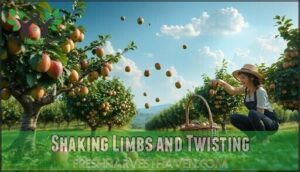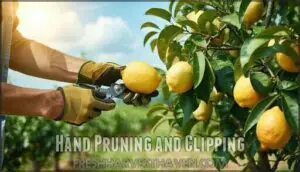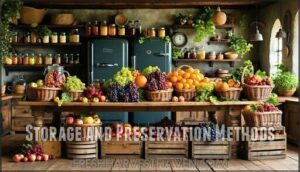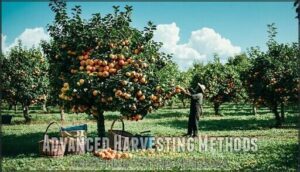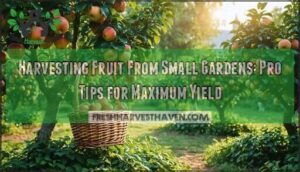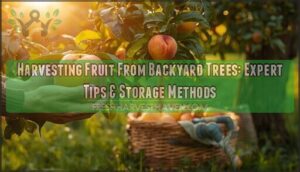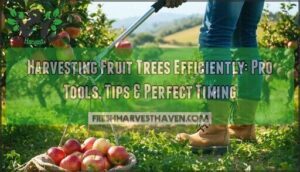This site is supported by our readers. We may earn a commission, at no cost to you, if you purchase through links.
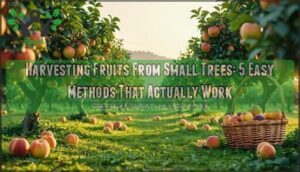 You’ll master harvesting fruits from small trees by timing it right and using proper technique.
You’ll master harvesting fruits from small trees by timing it right and using proper technique.
Pick during cool morning hours when sugar content peaks.
Test ripeness by gently lifting fruit – ripe specimens separate easily from branches without force.
Use the twist-and-lift method for most fruits, or employ long-handled picking tools for higher branches.
Handle your harvest like precious cargo since bruised fruit spoils quickly.
Stone fruits need gentle pressure testing near the stem, while apples should have developed their characteristic color.
Don’t yank or pull – you’re not wrestling with the tree!
Smart harvesting techniques can triple your yield while keeping your fruit trees healthy for years.
Table Of Contents
Key Takeaways
- You’ll maximize your harvest by timing fruit picking during cool morning hours when sugar content peaks, and testing ripeness by gently lifting fruit – ripe specimens separate easily without force.
- You can triple your yield by using the twist-and-lift method for most fruits and handling your harvest like precious cargo, since bruised fruit spoils quickly and damages your hard work.
- You’ll keep your trees productive for decades by preparing them through strategic winter pruning that reduces height and creates accessible fruiting zones within arm’s reach.
- You can extend your harvest’s shelf life substantially through proper post-harvest care including refrigeration at 32-40°F, maintaining 80-95% humidity levels, and using preservation methods like freezing or canning.
Harvesting Fruit Basics
You’ll master fruit harvesting when you understand three core principles: timing your harvest with weather conditions, handling fruit properly to prevent damage, and accurately evaluating ripeness using your senses rather than guessing.
These fundamentals form the foundation for successful fruit collection from your small trees, whether you’re picking your first apple or you’ve been at this gardening game for years.
The key to mastering these principles is understanding how they apply to successful fruit collection, and by following them, you can ensure a bountiful harvest from your trees.
Choose a Suitable Weather Day
Timing your harvest around the weather forecast makes all the difference.
Sunny mornings offer ideal conditions when dew evaporates but temperatures stay cool.
Avoid rainy days when wet fruit spoils faster and becomes slippery to handle.
Strong winds can damage both you and your tree, so wait for calmer conditions.
Cloud cover provides gentle light without harsh sun exposure during extended harvesting sessions, making it an ideal time to harvest under gentle conditions.
Know How to Handle Your Fruit
Your fruit deserves the same care you’d give a newborn baby.
Your perfect harvest moment arrives when weather, timing, and technique dance together in orchard harmony.
Gentle harvesting prevents fruit bruising that ruins your hard work.
Use both hands when fruit picking—one supports the branch while the other cradles each piece.
Avoid yanking or twisting aggressively.
Proper fruit handling means treating delicate skin like tissue paper, ensuring your harvest stays beautiful from tree to table, with gentle harvesting and proper care.
Fruit Ripeness Assessment
Your fruit testing game needs to rely on multiple senses, not just calendar dates.
Ripeness indicators vary dramatically between species, making visual color inspection and touch assessment your best friends. Sugar levels peak when fruits surrender easily to gentle pressure, while maintaining their structural integrity.
Understanding the fruit ripening process is vital for ideal harvesting.
- Color inspection reveals deep, uniform pigmentation in most varieties
- Touch assessment detects optimal firmness without mushiness or hardness
- Aroma evaluation indicates peak sugar development and volatile compounds
- Stem separation shows natural abscission layer formation at maturity
Fruit Tree Preparation
You can’t harvest fruit efficiently from an unprepared tree any more than you can pick apples while standing on your tiptoes in dress shoes.
Proper tree preparation through strategic pruning and training creates accessible fruiting zones that keep your harvest within comfortable reach.
Pruning for Easy Harvest
Why struggle with tall trees when smart tree pruning puts fruit within arm’s reach?
Winter pruning during dormant season encourages vigorous spring growth while reducing tree height. Cut vertical branches back one-third annually to maintain manageable size.
Effective pruning techniques, such as proper pruning cuts, are essential for achieving desired results.
| Prune Timing | Branch Type | Result |
|---|---|---|
| Winter | Vertical growth | Height control |
| Spring | Crossing branches | Better harvest access |
| Year-round | Dead/damaged limbs | Improved fruit thinning |
This approach to tree pruning allows for better control over the tree’s size and shape, making it easier to harvest fruit and maintain the tree’s health.
Training Young Trees
Your young tree’s future harvest depends on early branch training.
Start shaping dwarf fruit trees during their first growing season by selecting strong scaffold branches and removing competing shoots.
Use gentle ties to guide branches horizontally for better fruit support.
Proper tree shaping now means easier picking later.
Young tree care includes regular pruning to establish the framework that’ll support years of abundant harvests.
Effective disease prevention methods are essential for maintaining healthy trees and maximizing fruit production.
Proper tree shaping and regular care will lead to a successful harvest, making it important to follow these guidelines carefully for better fruit support and to ensure abundant harvests.
Soil and Climate Considerations
After establishing proper training, your soil and climate become the foundation for successful harvests.
Think of soil pH as your tree’s comfort zone—most fruit trees thrive between 6.0 and 6.5.
Here’s your soil preparation checklist:
- Test soil pH levels and adjust with lime or sulfur as needed
- Evaluate drainage systems to prevent waterlogged roots
- Match tree hardiness to your specific climate zones and microclimates
Harvesting Techniques
Once you’ve prepared your fruit trees properly, you’ll need specific techniques to harvest your crops without damaging the fruit or branches.
The right harvesting method depends on your fruit type and tree structure, but mastering these three core techniques will make collection safer and more efficient.
Trying to reach every apple like you’re playing fruit Jenga is not an efficient method, and instead, these techniques will improve your harvesting process.
Shaking Limbs and Twisting
Gentle shaking transforms harvest day from wrestling match to dance.
Grab sturdy branches and shake with rhythmic pulses—not violent jerks that damage bark.
Stone fruits like plums respond beautifully to this limb shaking technique.
For individual fruits, use the twist-and-lift method: rotate gently until the stem releases naturally.
This fruit handling approach prevents bruising while maximizing your harvest efficiency.
Using Fruit Picker Tools
Telescoping pole pickers extend your reach up to 13 feet, eliminating dangerous ladder climbing.
These fruit harvesting tools feature adjustable baskets that cushion delicate produce during collection.
Quality tool kits include telescoping pickers with interchangeable heads, harvest baskets, and gardening gloves for complete protection.
Choose modular designs that accommodate apples, pears, and citrus fruits with specialized attachments for ideal results.
For efficient harvesting, consider using proper fruit harvesting tools to handle various types of fruits.
Hand Pruning and Clipping
Hand pruners and pruning shears give you surgical precision when harvesting delicate citrus fruits like lemons and tangerines.
These pruning tools let you clip stems cleanly without damaging branches or bruising fruit. Master proper clip methods by cutting just above the fruit’s attachment point.
Good fruit handling starts with sharp, clean pruning techniques that protect both harvest and tree health. Effective gardening also involves using the right pruning shear tools to maintain plant health and ensure a successful harvest with proper clip methods.
Post Harvest Care
You’ve successfully picked your homegrown fruit, but your work isn’t finished yet.
Proper post-harvest care determines whether your fresh fruit stays crisp for weeks or turns into expensive compost within days.
Storage and Preservation Methods
After collecting your harvest, proper fruit storage becomes your next priority.
Traditional preservation methods like fruit canning and dehydration methods extend shelf life substantially. Modern refrigeration tips help maintain freshness for weeks.
- Fruit freezing – Wash, dry, and freeze in airtight containers to preserve nutritional value
- Cold storage tips – Use newspaper-lined boxes in cool, dark spaces for extended preservation
- Fruit preservation – Process into jams, jellies, or pickled solutions for year-round enjoyment
To maximize nutrient retention, this is vital to understand the importance of proper harvesting methods in maintaining the quality of your harvested fruits.
Optimal Storage Conditions
Three key factors determine successful fruit storage: temperature, humidity, and air circulation.
You’ll need consistent refrigeration between 32-40°F for most fruits.
Humidity control should maintain 80-95% moisture levels to prevent shriveling.
| Storage Factor | Ideal Range | Management Tips |
|---|---|---|
| Temperature | 32-40°F | Use thermometer monitoring |
| Humidity | 80-95% | Add damp towels if needed |
| Air Flow | Gentle circulation | Avoid sealed containers completely |
Ethylene management prevents premature ripening through proper fruit shelving and storage containers.
Proper fruit shelving and gentle air circulation are crucial for maintaining the quality of the fruits.
Freezing and Refrigeration
Your harvest’s longevity depends on proper temperature control and cold chain management.
Refrigeration at 32-40°F extends shelf life substantially, while freezer storage at 0°F preserves fruit for months.
Fruit blanching before frozen preservation maintains color and texture.
Follow these refrigeration tips: avoid washing before cold storage, use airtight containers, and maintain consistent freezing temps throughout.
Advanced Harvesting Methods
You’ve mastered the basics, so now it’s time to upgrade your fruit-gathering game with professional-grade techniques that’ll make your neighbors wonder if you’ve secretly enrolled in orchard management school.
Advanced harvesting methods combine specialized equipment, precise timing systems, and strategic tree management to maximize both yield and fruit quality while keeping your feet firmly planted on solid ground.
This approach allows for the application of precise timing systems to further enhance the fruit-gathering process, ensuring optimal results.
Using Ladders and Buckets
When you’re dealing with taller fruit trees, portable ladders become your best friend for safe tree access.
Choose sturdy A-frame ladders with non-slip feet for superior ladder safety.
Pair them with lightweight buckets featuring comfortable handles for efficient fruit handling.
This classic combo of harvest tools transforms challenging picks into manageable tasks, giving you complete freedom to reach every branch, with superior ladder safety, and enjoy efficient fruit handling.
Pruning Shears and Tool Kits
Sharp shears become your secret weapon when harvesting delicate fruits that bruise easily.
Quality cutting tools in your gardening tools arsenal prevent stem damage while ensuring clean cuts. Garden loppers handle thicker branches, while precision pruning shears tackle tender stems.
A complete tool kit with sharp blades transforms frustrating harvests into smooth operations, giving you mastery over every picking session. Investing in proper Gardening Shears is essential for efficient harvesting with the right tools.
AI-Powered Sizing Systems
Modern technology transforms fruit tree harvesting with AI-powered systems that revolutionize how you manage your small orchard.
AI-powered fruit harvesting turns your backyard orchard into a high-tech precision operation that would make commercial growers jealous.
These smart sizing solutions bring precision to your harvest.
- Fruit Sorting: AI technology categorizes fruits by size with 95% accuracy
- Size Detection: Computer vision measures dimensions in real-time during harvest
- Automated Harvest: Smart systems process thousands of fruits per hour
- AI Technology: Neural networks classify ripeness and quality instantly
- Smart Sizing: Machine learning adapts to different fruit varieties automatically
Frequently Asked Questions (FAQs)
How often should small fruit trees be fertilized?
Back in the telegraph era, gardeners knew timing mattered most.
You’ll fertilize young fruit trees three times annually—early spring, mid-summer, and fall.
Mature trees need feeding twice yearly: spring awakening and post-harvest recovery for ideal nutrient cycling.
What causes fruit drop before harvest time?
Premature fruit drop happens when you’re dealing with stress factors like inconsistent watering, nutrient deficiencies, or overcrowding.
Your tree’s basically saying "I can’t support all this fruit!" so it drops some naturally, which is a natural response to the stress it’s experiencing, often due to stress factors.
Can you grow fruit trees in containers indoors?
Like houseplants that suddenly bloom indoors, dwarf citrus trees thrive in containers with proper care.
You’ll need bright light, well-draining soil, and regular feeding.
Most varieties produce fruit within two years, which can be considered a complete concept of their growth cycle.
Which fruit varieties pollinate each other effectively?
Apple varieties like Gala and Honeycrisp cross-pollinate beautifully, while most citrus trees are self-fertile.
You’ll need at least two different apple cultivars blooming simultaneously for proper fruit set and maximum yields.
How do you prevent birds from eating fruit?
Don’t count your chickens before they hatch—birds’ll beat you to your fruit.
Install reflective tape, bird netting, or decoy owls around trees.
Harvest early morning when birds aren’t active, and consider companion planting with berry bushes as distractions.
Conclusion
Home orchardists lose up to 40% of their crop through improper picking techniques, but you don’t have to join that statistic.
Mastering harvesting fruits from small trees means respecting your tree’s natural rhythms and using gentle methods.
Remember: patience beats force every time.
Whether you’re twisting apples or catching falling peaches, these five techniques will keep your trees productive for decades, and your future self will thank you when you’re enjoying homegrown fruit year after year.
- https://edis.ifas.ufl.edu/publication/HS1459
- https://www.echocommunity.org/en/resources/19bdba0a-a6fe-42e7-91bd-134fd3e942ac
- https://extension.uga.edu/publications/detail.html?number=B1555&title=peaches-appropriate-harvest-and-postharvest-handling
- https://www.researchgate.net/publication/257723717_Review_on_fruit_harvesting_method_for_potential_use_of_automatic_fruit_harvesting_systems
- https://www.sciencedirect.com/science/article/pii/S0925521423003484


